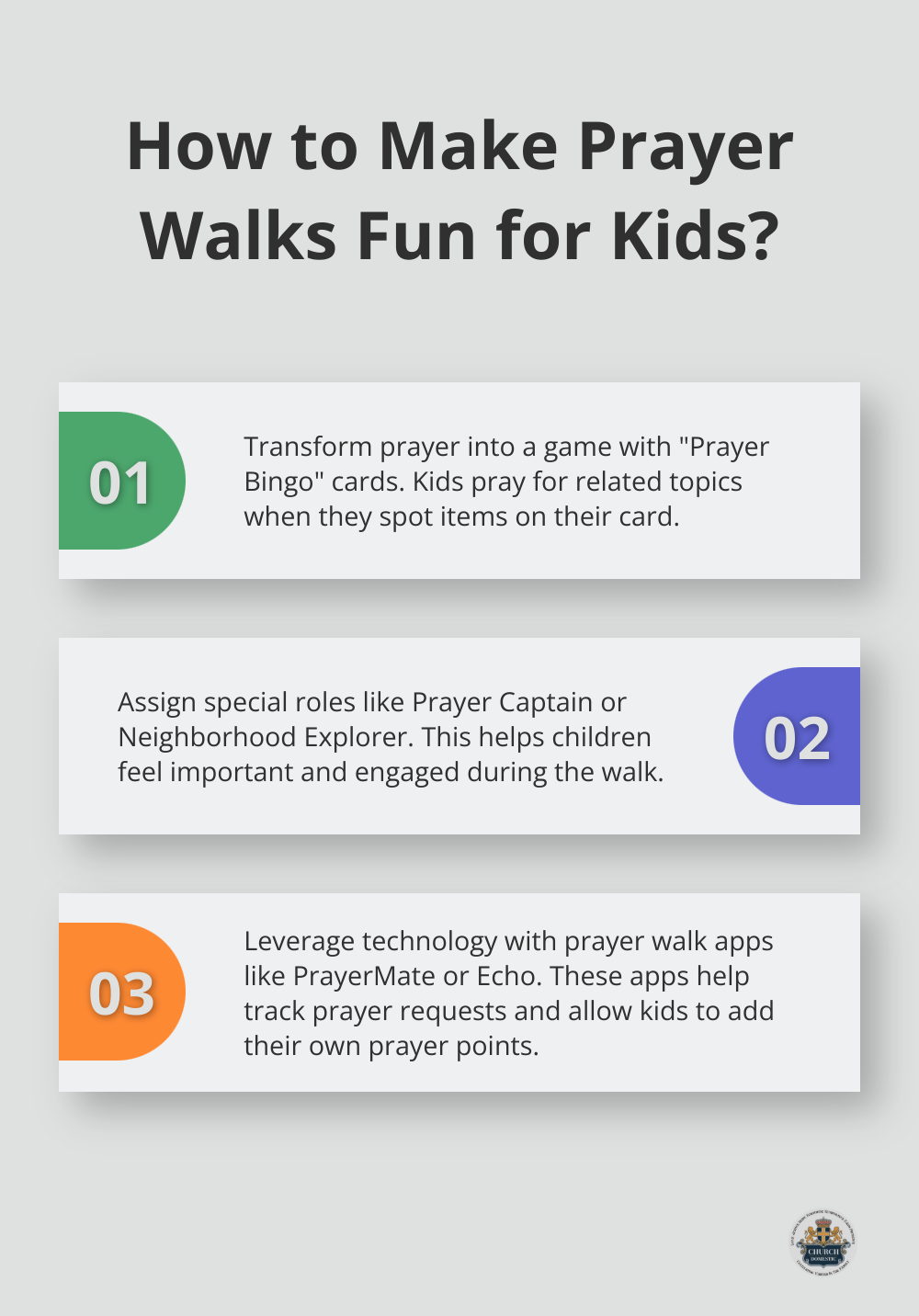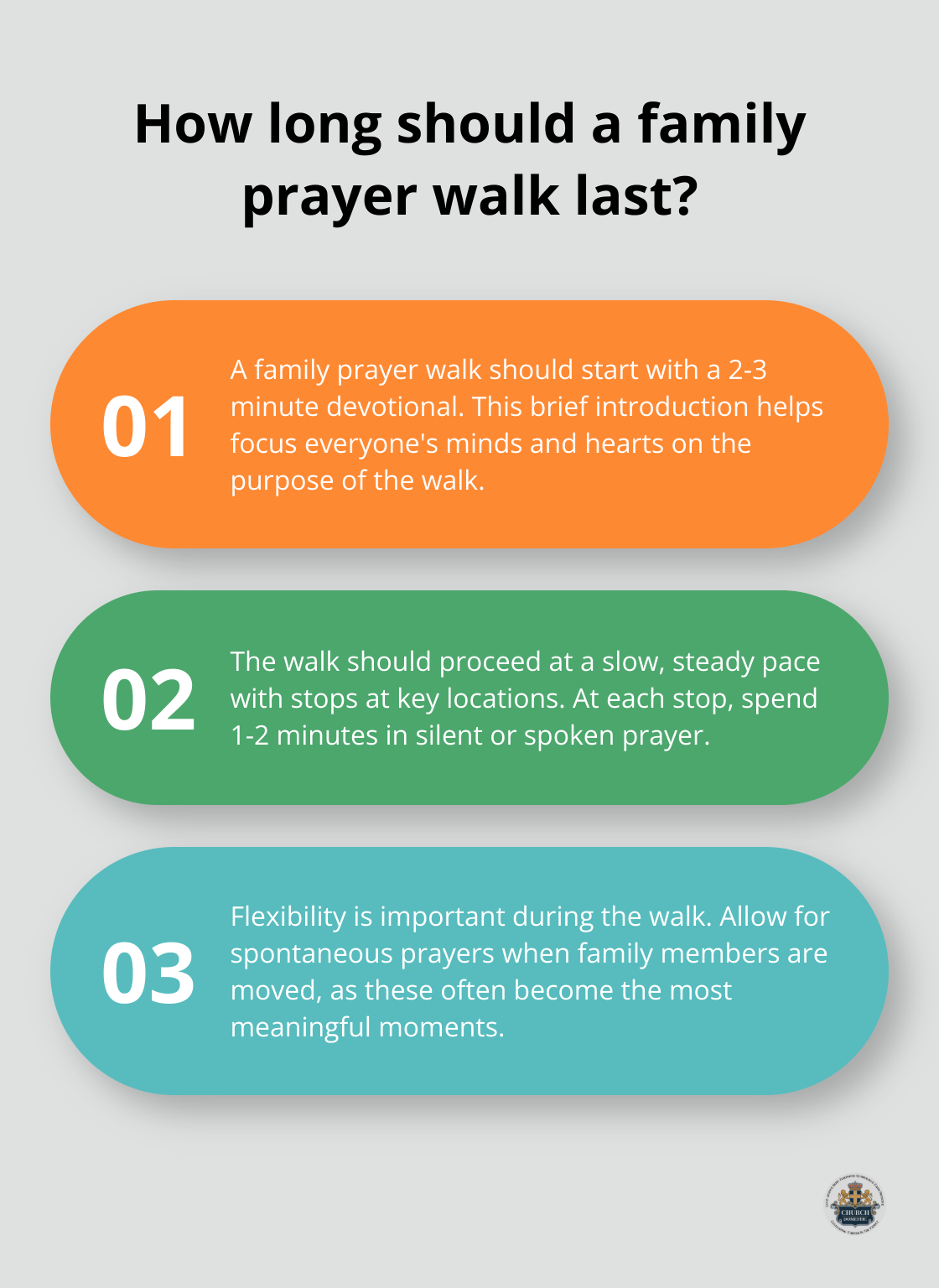At Church Domestic, we believe in the power of family prayer to transform neighborhoods. A prayer walk is a simple yet profound way to engage your entire family in spiritual growth and community connection.
This guide will show you how to lead a meaningful prayer walk with your loved ones, fostering a spirit of unity and compassion for your neighbors.
How to Plan Your Family Prayer Walk
Mapping Your Route
Select a route that’s safe and accessible for all family members. Choose places to visit and look for route diversity. Use public footpaths when available. Determine a distance, start, and end point that works for your family. Consider using Google Maps to plan and save your route, which makes it easy to follow and share with your family.
Scheduling for Success
Pick a time that accommodates everyone’s schedule. Early evenings often work well, as most family members are likely to be free. Weekends can also be a great option. Set a recurring date, such as the first Saturday of each month, to establish a routine. A shared family calendar app helps keep everyone informed and on the same page.
Crafting Meaningful Prayer Points
Prepare a list of relevant prayer points to make your walk impactful. Research your community’s needs by checking local news sources or community Facebook groups. Include prayers for:
- Local leaders
- Businesses facing challenges
- Specific community issues
For example, if there’s a new housing development, pray for the incoming families. If a local school struggles, add that to your list.

Keep your prayer points concise and specific. Instead of a general “pray for our neighbors,” try “pray for the Johnson family who just moved in at 123 Oak Street.” This specificity helps children engage more deeply and makes the experience more tangible for everyone involved.
Preparing Materials
Gather any materials you might need for the walk. This could include:
- Printed maps (in case of poor cell reception)
- Water bottles
- Comfortable walking shoes
- A small notebook and pen for jotting down observations
Setting the Tone
Before you head out, take a few minutes to explain the purpose of the prayer walk to your family. Discuss the importance of being respectful and observant during the walk. You might want to start with a short prayer or read a relevant Bible verse to set a spiritual tone for the experience.
As you finalize your plans, you’ll want to consider how to keep younger family members engaged throughout the walk. Let’s explore some creative ways to involve children in this meaningful family activity.
How to Engage Kids in Family Prayer Walks
Turn Prayer into a Game
Transform your prayer walk into an exciting adventure for children. Create a “Prayer Bingo” card featuring items they might spot during the walk (e.g., a red door, a flower garden, or a bicycle). When kids see an item, they pray for a related topic. For instance, a red door could prompt a prayer for the family living in that house.
Assign Special Roles
Give each child a specific responsibility during the walk. One child could become the Prayer Captain, leading a short prayer at each stop. Another might take on the role of “Neighborhood Explorer,” pointing out new things they notice. These roles help children feel important and engaged throughout the walk.
Leverage Technology Wisely
For tech-savvy kids, consider using a prayer walk app (such as PrayerMate or Echo). These apps help children track prayer requests and set reminders. You can create a family prayer list within the app, allowing kids to add their own prayer points as you walk.
Encourage Sensory Awareness
Teach children to use their senses during the prayer walk. Ask them to listen for sounds like birds chirping or cars passing, then pray for what they hear. They can look for colors and pray for different aspects of creation. This approach helps children stay present and engaged with their surroundings.
Create a Prayer Journal
Provide each child with a small notebook to use as a prayer journal during the walk. Encourage them to write or draw their observations and prayers. This not only keeps them engaged during the walk but also creates a meaningful keepsake of their spiritual journey.
Incorporate Movement
For energetic kids, add physical elements to the prayer walk. They could do a jumping jack for each house they pray for or take a giant step when they spot something to be thankful for. This combines prayer with physical activity, making it more engaging for active children.

The key to a successful family prayer walk lies in making it interactive and age-appropriate. These creative approaches not only teach children about prayer but also help them develop a heart for their community. As you prepare to embark on your family prayer walk, let’s explore how to conduct the walk itself for maximum impact and spiritual growth.
How to Lead Your Family Prayer Walk
Set the Tone with a Brief Devotional
Start your family prayer walk with a short devotional. Read a Bible verse that aligns with your walk’s purpose. Matthew 5:14-16 about being the light of the world fits well. Try to keep it to 2-3 minutes. This focuses everyone’s minds and hearts on the task ahead.
Walk with Purpose and Pace
Set off at a slow, steady pace. This isn’t a race or exercise – it’s a time for reflection and prayer. Stop at key locations like schools, businesses, or homes of people you know are struggling. At each stop, spend 1-2 minutes in silent or spoken prayer.
Guide Your Family’s Prayers
Use specific prompts to direct prayers. Instead of general requests, try targeted ones:
- For the local elementary school: “Lord, bless the teachers with patience and wisdom.”
- For a struggling business: “Father, provide new opportunities for growth for this store.”
- For your neighbors: “God, help the family at number 42 who recently lost a loved one.”

These specific prayers help everyone (especially children) connect more deeply with the needs around them.
Engage All Senses
Encourage your family to use all their senses during the walk. What do they smell? What sounds do they hear? These observations can spark prayers. The scent of fresh bread from a bakery might prompt gratitude for local businesses. The sound of children playing could inspire prayers for the neighborhood’s youth.
Using sensory observations in prayer can be particularly meaningful for individuals with sensory sensitivities, who often have a deep desire for authenticity and genuineness in their worship experience.
Allow for Spontaneity
Flexibility is key. If a family member spots something that moves them to pray, stop and allow that moment. These spontaneous prayers often become the most meaningful parts of the walk (and can lead to unexpected insights about your community).
Final Thoughts
Conclude your family prayer walk with a moment of reflection. Share observations, insights, and answered prayers you witnessed along the way. This reflection solidifies the impact of your walk and reinforces the power of prayer in your family’s life.

Make prayer walks a regular part of your family routine. Consistent prayer walks deepen your connection with your community and strengthen your family’s faith. You might rotate leadership among family members, allowing each person to choose the route or prayer focus for different walks.
The impact of your prayer walk extends beyond the time spent walking. We at Church Domestic believe in the transformative power of family activities like prayer walks. Our mission provides resources and support for families who seek to strengthen their faith and positively impact their communities.